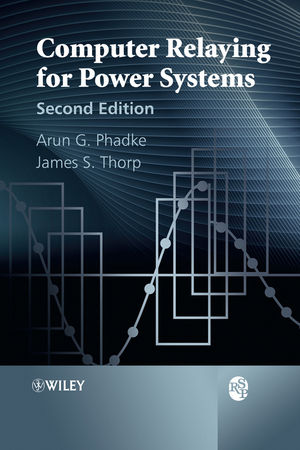Computer Relaying for Power Systems, 2nd EditionISBN: 978-0-470-05713-1
Hardcover
344 pages
August 2009
 This is a Print-on-Demand title. It will be printed specifically to fill your order. Please allow an additional 10-15 days delivery time. The book is not returnable.
|
||||||
Preface to the First Edition.
Preface to the Second Edition.
Glossary of Acronyms.
1 Introduction to computer relaying.
1.1 Development of computer relaying.
1.2 Historical background.
1.3 Expected benefits of computer relaying.
1.4 Computer relay architecture.
1.5 Analog to digital converters.
1.6 Anti-aliasing filters.
1.7 Substation computer hierarchy.
1.8 Summary.
Problems.
References.
2 Relaying practices.
2.1 Introduction to protection systems.
2.2 Functions of a protection system.
2.3 Protection of transmission lines.
2.4 Transformer, reactor and generator protection.
2.5 Bus protection.
2.6 Performance of current and voltage transformers.
2.7 Summary.
Problems.
References.
3 Mathematical basis for protective relaying algorithms.
3.1 Introduction.
3.2 Fourier series.
3.3 Other orthogonal expansions.
3.4 Fourier transforms.
3.5 Use of fourier transforms.
3.6 Discrete fourier transform.
3.7 Introduction to probability and random process.
3.8 Random processes.
3.9 Kalman filtering.
3.10 Summary.
Problems.
References.
4 Digital filters.
4.1 Introduction.
4.2 Discrete time systems.
4.3 Discrete time systems.
4.4 Z Transforms.
4.5 Digital filters.
4.6 Windows and windowing.
4.7 Linear phase.
4.8 Approximation – filter synthesis.
4.9 Wavelets.
4.10 Elements of artificial intelligence.
4.11 Conclusion.
Problems.
References.
5 Transmission line relaying.
5.1 Introduction.
5.2 Sources of error.
5.3 Relaying as parameter estimation.
5.4 Beyond parameter estimation.
5.5 Symmetrical component distance relay.
5.6 Newer analytic techniques.
5.7 Protection of series compensated lines.
5.8 Summary.
Problems.
References.
6 Protection of transformers, machines and buses.
6.1 Introduction.
6.2 Power transformer algorithms.
6.3 Generator protection.
6.4 Motor protection.
6.5 Digital bus protection.
6.6 Summary.
Problems.
References.
7 Hardware organization in integrated systems.
7.1 The nature of hardware issues.
7.2 Computers for relaying.
7.3 The substation environment.
7.4 Industry environmental standards.
7.5 Countermeasures against EMI.
7.6 Supplementary equipment.
7.7 Redundancy and backup.
7.8 Servicing, training and maintenance.
7.9 Summary.
References.
8 System relaying and control.
8.1 Introduction.
8.2 Measurement of frequency and phase.
8.3 Sampling clock synchronization.
8.4 Application of phasor measurements to state estimation.
8.5 Phasor measurements in dynamic state estimation.
8.6 Monitoring.
8.7 Control applications.
8.8 Summary.
Problems.
References.
9 Relaying applications of traveling waves.
9.1 Introduction.
9.2 Traveling waves on single-phase lines.
9.3 Traveling waves on three-phase lines.
9.4 Directional wave relay.
9.5 Traveling wave distance relay.
9.6 Differential relaying with phasors.
9.7 Traveling wave differential relays.
9.8 Fault location.
9.9 Other recent developments.
9.10 Summary.
Problems.
References.
10 Wide area measurement applications.
10.1 Introduction.
10.2 Adaptive relaying.
10.3 Examples of adaptive relaying.
10.4 Wide area measurement systems (WAMS).
10.5 WAMS architecture.
10.6 WAMS based protection concepts.
10.7 Summary.
Problems.
References.
Appendix A.
Representative system data.
Transmission lines.
Transformers.
Generators.
Power system.
References.
Appendix B.
Standard sampling rates.
References.
Appendix C.
Conversion between different sampling rates.
References.
Appendix D.
Standard for transient data exchange.
References.
Index.



